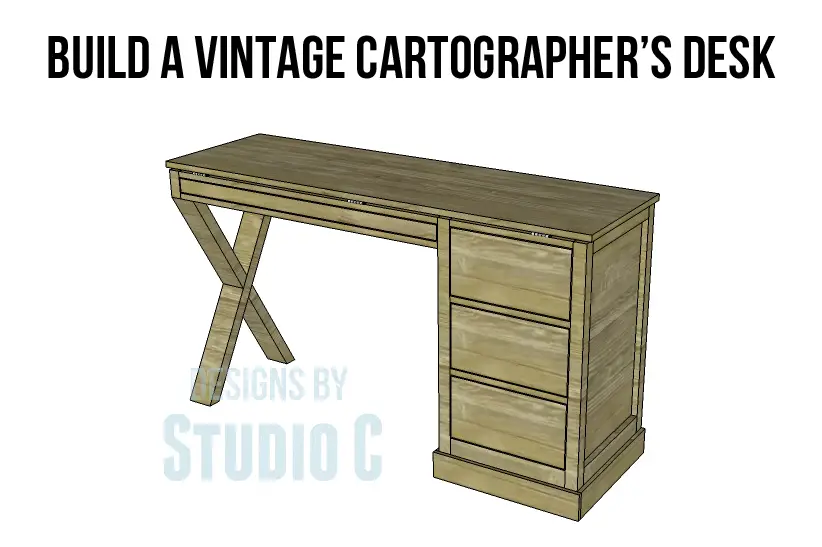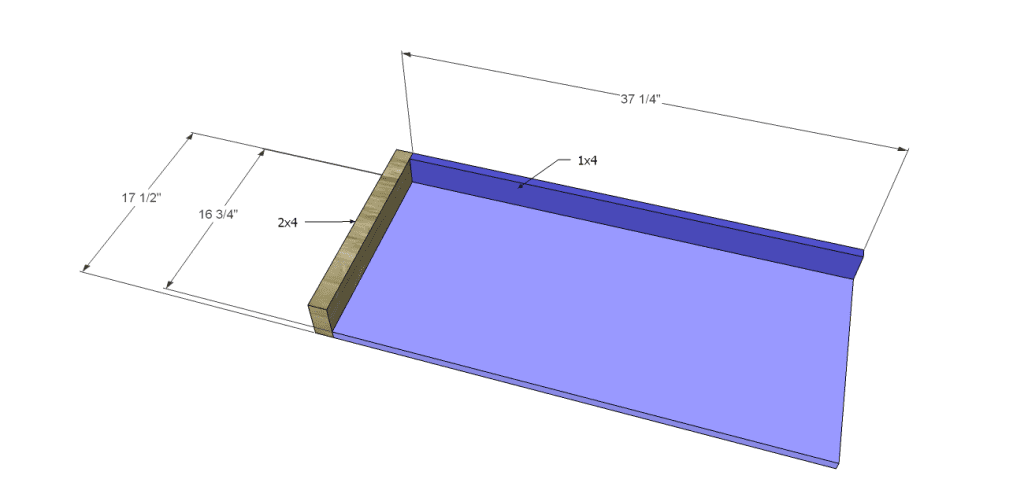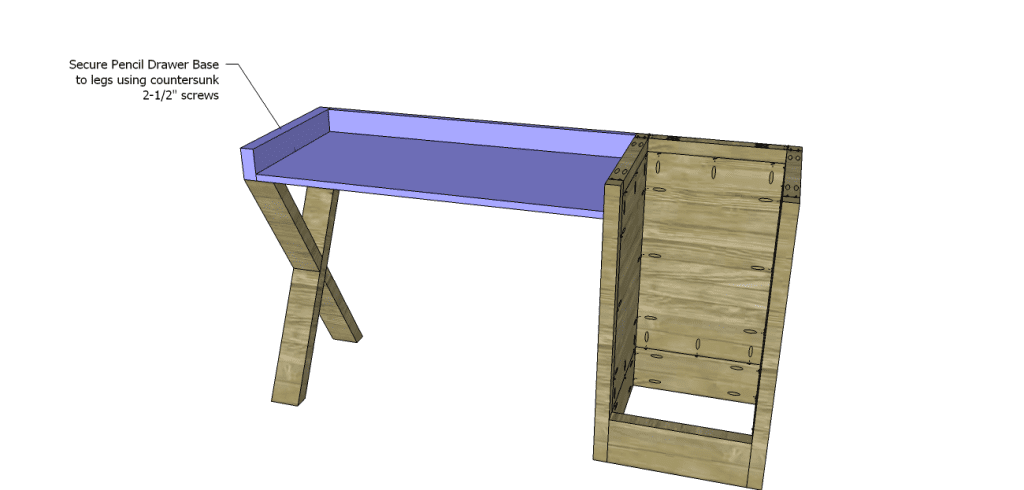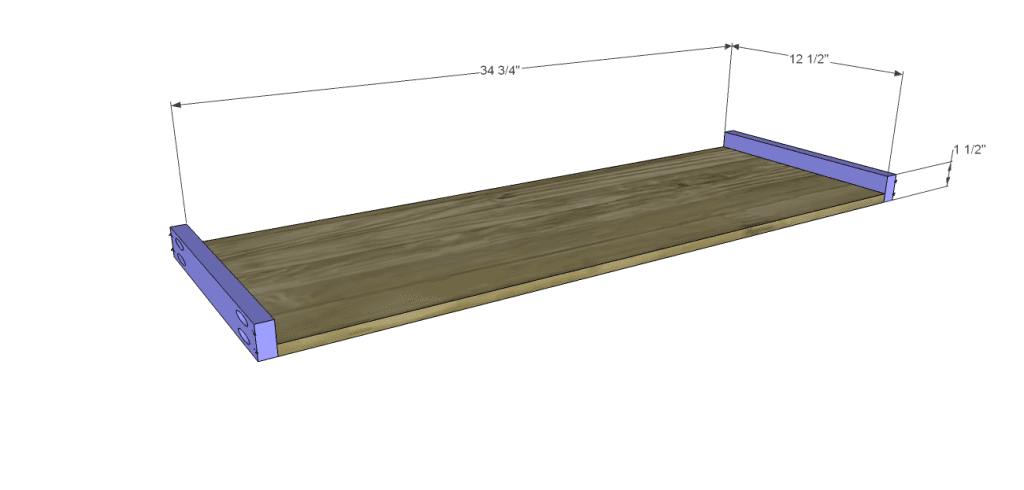DIY Plans to Build a Desk
Easy DIY Plans to Build a Vintage Cartographer’s Desk
This is a really cool desk! Styled after a vintage cartographer’s (map maker’s) desk, it packs a powerful punch with style and storage! Featuring a top that can be elevated at an angle, the desk has one narrow center drawer for pencils or paperwork, and three larger drawers to the side. An X-shaped leg adds to the style!


Materials:
- 1-1/4″ pocket hole screws
- 2-1/2″ pocket hole screws
- 2-1/2″ screws
- 1-1/4″ brad nails
- 1 continuous hinge (or 3 smaller hinges) for the top
- 2 non-mortise hinges (for the Top Supports)
- 2 – 1″ earth magnets and small squares of metal (to secure the Top Supports when not in use)
- Edge banding, optional
- 4 sets of 14″ Drawer slides
- 5 Cabinet pulls
- Wood glue
- Sandpaper (100, 150, 220 grits)
- Finishing supplies (primer & paint, or stain, sealer)
Lumber:
- 1 – 1×2 at 6′
- 2- 1×2 at 8′
- 1 – 1×4 at 8′
- 1 – 2×2 at 4′
- 2 – 2×2 at 6′
- 1 – 2×4 at 8′
- 1 – 2×6 at 6′
- 1 half sheet of 3/4″ plywood
- 1 full sheet of 3/4″ plywood
Cut List:
- 4 – 2×2 at 31-1/4″ – Legs
- 3 – 2×2 at 14-1/2″ – Side & Back Frames
- 4 – 2×6 (ripped to 5-3/8″ wide) at 14-1/2″ – Side & Back Frames, Lower Front Stretcher
- 3 – 3/4″ plywood at 14-1/2″ x 24-3/8″ – Side & Back Panels
- 1 – 2×4 at 32-3/4″ – X Leg
- 2 – 2×4 at 15-15/16″ – X Leg
- 1 – 2×4 at 17-1/2″ – Pencil Drawer Base
- 1 – 1×4 at 37-1/4″ – Pencil Drawer Base
- 1 – 3/4″ plywood at 16-3/4″ x 37-1/4″ – Pencil Drawer Base
- 5 – 1×2 at 14-1/2″ – Pencil Drawer Slide Spacer & Front Stretchers
- 2 – 1×2 at 37-1/4″ – Front Stretcher & Top Support Ledge
- 1 – 1×2 (ripped to 3/4″) at 14-1/2″ – Top Support Ledge
- 1 – 3/4″ plywood at 12-1/2″ x 34-3/4″ – Pencil Drawer Bottom
- 2 – 1×2 at 12-1/2″ – Pencil Drawer Sides
- 2 – 1×2 at 36-1/4″ – Pencil Drawer Front & Back
- 3 – 3/4″ plywood at 12″ x 12-1/2″ – Drawer Bottoms
- 6 – 1×6 at 12-1/2″ – Drawer Sides
- 6 – 1×6 at 13-1/2″ – Drawer Front & Back
- 1 – 3/4″ plywood at 1-3/4″ x 37″ – Pencil Drawer Front
- 3 – 3/4″ plywood at 7-5/8″ x 14-1/4″ – Drawer Fronts
- 2 – 1×4 at 17-1/2″ – Lower Trim
- 1 – 1×4 at 18-1/2″ – Lower Trim
- 1 – 3/4″ plywood at 17-1/2″ x 57-1/4″ – Top
- 2 – 1×4 at 12-3/16″ – Top Supports

Notes About the Project:
Edge banding will be applied to the exposed edges of the plywood before assembly.
Step One
Cut the pieces for the side legs, side frames, and panels. With the pocket hole jig set for 1-1/2″ material, drill pocket holes in each end of the frame pieces. Set the pocket hole jig for 3/4″ material and drill pocket holes in all four edges of the panels. Secure the frame pieces to the panels using glue and 1-1/4″ pocket hole screws. Secure the entire panel assembly to the legs using glue and 2-1/2″ pocket hole screws through the frame pieces, and 1-1/4″ pocket hole screws through the panels into the legs.

Step Two
Cut the pieces for the back frame and panel. With the pocket hole jig set for 1-1/2″ material, drill pocket holes in each end of the frame pieces. Set the pocket hole jig for 3/4″ material and drill pocket holes in all four edges of the panel. Secure the frame pieces to the panel using glue and 1-1/4″ pocket hole screws. Secure the entire panel assembly to the legs using glue and 2-1/2″ pocket hole screws through the frame pieces, and 1-1/4″ pocket hole screws through the panel into the legs.

Step Three
Cut the piece for the lower front stretcher. Set the pocket hole jig for 1-1/2″ material and drill pocket holes in each side of the piece. Secure the stretcher to the legs using glue and 2-1/2″ pocket hole screws.

Step Four
Cut the pieces for the X leg. Cut the angles as indicated in the drawing, and drill pocket holes in each side of the shorter pieces as indicated. Assemble the X leg as shown using glue and 2-1/2″ pocket hole screws.


Step Five
Cut the pieces for the pencil drawer base. Set the pocket hole jig for 3/4″ material and drill pocket holes in all four edges of the bottom, as well as each end of the 1×4 piece. Assemble the pencil drawer base as shown using glue and 1-1/4″ pocket hole screws. Secure the pencil drawer base to the side drawer base using glue and 1-1/4″ pocket hole screws. Secure the X leg to the pencil drawer base using glue and countersunk 2-1/2″ screws through the bottom into the top of the legs.


Step Six
Cut the pieces for the stretchers and drill pocket holes in each end. Position as shown, then secure using glue and 1-1/4″ pocket hole screws.

Step Seven
Cut the piece for the pencil drawer spacer. Secure as shown using glue and 1-1/4″ brad nails.

Step Eight
Cut the pieces for the top support ledge. Secure to the inside of the upper edge as shown (locating the pieces 3/4″ down) using glue and 1-1/4″ brad nails. The longer ledge will be fastened from the outside of the back, and the shorter ledge will be fastened from the inside.

Step Nine
Cut the pieces for the drawer boxes. Drill pocket holes in all four edges of the bottom as well as each end of the sides. Assemble the drawer box as shown using glue and 1-1/4” pocket hole screws. Install the drawer slides according to the manufacturer’s installation instructions, locating them ¾” back from the front edge of the sides. Read this easy tutorial on installing drawer slides for additional information! Make any necessary adjustments.




Step Ten
Cut the pieces for the drawer fronts. Mark the position for the drawer pulls and drill the holes. Shim the drawer front in the opening – there will be a 1/8” gap around all sides – then drive screws through the holes for the drawer pulls into the drawer box. Open the drawer, and secure the drawer front using countersunk 1-1/4” screws from the inside. Remove the screws from the holes for the drawer pull then finish drilling the holes. Install the drawer pull. This easy tutorial on installing drawer fronts will make the installation easier!

Step Eleven
Cut the pieces for the lower trim. Fasten the side pieces first, then fasten the front piece.

Step Twelve
Cut the piece for the top. The front will be flush with the cabinet and the sides will overhang by 1/2″ on each side. Attach the hinges to the top according to the manufacturer’s instructions, then attach the hinges to the upper stretchers.

Step Thirteen
Cut the pieces for the top supports. Cut the bevels in each end as shown. Bore a hole on the inside face of each support so the magnet will sit inside and flush. Secure with glue (Liquid Nails, or something similar). Attach the non-mortise hinges to each support leg, then attach to the top locating them approximately 1-3/4″ down from the back edge so they will clear the back edge of the cabinet. Attach the small squares of metal to the underside of the top where the magnets will make contact with them when the top supports are not in use.


Finish as desired.
These DIY plans to build a desk will help show off your awesome skills! Need help with the plan? Contact me at cher {at} designsbystudioc {dot} com!
Originally posted 2013-11-25 08:00:40.


Wow that’s some piece of good looking furniture!
Thank you, Elle, I love it as well!
It looks really cool! So vintage looking too 🙂 I am amazed at your talent Cher! It’s God given…
Thank you, Vinma, I do appreciate it!
Each time I see one of your posts, I want a brand new house I can fill with your stuff in it. 😀
Well, as usual, your illustrations rock, love your blog!
Love this desk. My son would be all over it for his drawing.
I love it, also! This is another I would love to add to my to-do list but I don’t have room for it!
I’m looking forward to building this. I think the flip top could be used to mod in some electronics and technology and have some fun….
YES!! That would be incredibly awesome! Are you thinking maybe a power strip, usb ports, or speakers? I think having built-in speakers would be amazing! Good luck with the build and let me know how it goes! Thank you for stopping by!!
Also, I will post a link to this page on the post once it’s up 🙂
Thank you, John, I appreciate that!